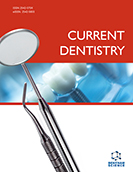
Full text loading...
We use cookies to track usage and preferences.I Understand
Background: Dental resin composites undergo chemical and mechanical degradation. Thus, the orthodontist should evaluate aged composite restoration surfaces to select the appropriate protocol to successfully bond orthodontics accessories.
Objective: This study evaluated the shear bond strength (σ) of metal (M) and ceramic (C) brackets bonded to aged resin-based composite restorations (ACR) after different surface treatments.
Methods: ACR specimens (N=160) were fabricated and divided into 8 experimental groups (n=20) as follows: Mo (control)- M bonded to ACR; MA- M bonded to ACR after acid etching using 38% phosphoric acid for 20 s (A); MB- M bonded to ACR after surface roughing using a twelve-bladed bur (B); MBA- M bonded to ACR after B and A; Co (control)- C bonded to ACR; CA- C bonded to ACR after A; CB- C bonded to ACR after B; CBA- C bonded to ACR after B and A. All specimens were stored for 24h before σ testing. Data were statistically analyzed using one-way ANOVA and Tukey post-hoc (α=0.05). Fracture surfaces were examined to determine the failure mode.
Results: The surface treatments (A, B and BA) produced similar σ values (p>0.05) to ACR when using the same bracket type. M bracket showed greater σ than C bracket (p<0.05), probably because of different mechanical retention inherent from bracket type. Inhomogeneous stress distribution generated complex failures.
Conclusion: Considering the needs of an orthodontic treatment and the surface treatments evaluated, sufficient bond strength was produced to ACR, irrespective of bracket type.

Article metrics loading...

Full text loading...
References


Data & Media loading...

